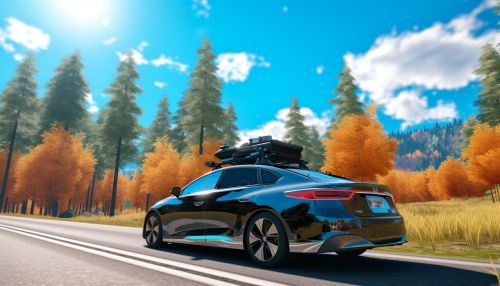Deep Learning in Autonomous Vehicles
Introduction
Deep learning, a subset of machine learning, is a key technology in the development of autonomous vehicles. It enables vehicles to learn from vast amounts of data and make decisions based on patterns and experiences, much like humans do. This technology is being used to develop and enhance various aspects of autonomous vehicles, including perception, decision-making, and control systems.
Deep Learning
Deep learning is a type of machine learning that uses neural networks with many layers - hence the term 'deep'. These neural networks are algorithms modeled after the human brain, designed to recognize patterns. They interpret sensory data through a kind of machine perception, labeling or clustering raw input. The patterns they recognize are numerical, contained in vectors, into which all real-world data, be it images, sound, text or time series, must be translated.
Deep Learning in Perception Systems
Perception systems in autonomous vehicles are responsible for understanding the vehicle's surroundings. This includes detecting and recognizing other vehicles, pedestrians, traffic signs, and lane markings, among other things. Deep learning plays a crucial role in these systems, particularly in the areas of object detection, object recognition, and scene understanding.
Object Detection
Object detection involves identifying objects within an image or a video stream. In autonomous vehicles, this is typically done using cameras, LiDAR, and radar sensors. Deep learning models, such as Convolutional Neural Networks (CNNs), are commonly used for this task. These models are trained on large datasets containing images of various objects, and they learn to detect these objects in new, unseen images.
Object Recognition
Once objects have been detected, the next step is to recognize what these objects are. This involves classifying the detected objects into various categories, such as 'car', 'pedestrian', or 'traffic sign'. Again, deep learning models, particularly CNNs, are used for this task. These models are trained on large datasets containing labeled images of various objects, and they learn to classify new, unseen objects based on this training.
Scene Understanding
Scene understanding involves understanding the entire scene around the vehicle, including the relationships between different objects, the layout of the scene, and the context. This is crucial for autonomous vehicles, as it allows them to understand their surroundings and make appropriate decisions. Deep learning models, such as Recurrent Neural Networks (RNNs) and Long Short-Term Memory (LSTM) networks, are used for this task. These models are capable of understanding temporal sequences, which makes them suitable for understanding dynamic scenes.
Deep Learning in Decision-Making Systems
Decision-making systems in autonomous vehicles are responsible for making decisions based on the understanding of the vehicle's surroundings. This includes decisions about steering, acceleration, and braking, as well as high-level decisions about navigation and planning. Deep learning plays a crucial role in these systems, particularly in the areas of policy learning, value estimation, and imitation learning.
Policy Learning
Policy learning involves learning a policy, i.e., a mapping from states to actions. In the context of autonomous vehicles, this means learning to make appropriate decisions based on the current state of the vehicle and its surroundings. Deep learning models, such as Deep Q-Networks (DQNs) and Policy Gradient methods, are used for this task. These models are trained using reinforcement learning, where they learn to make decisions by interacting with the environment and receiving feedback in the form of rewards or penalties.
Value Estimation
Value estimation involves estimating the expected future reward for each possible action in each possible state. This is crucial for making optimal decisions, as it allows the vehicle to evaluate the potential consequences of its actions. Deep learning models, such as DQNs, are used for this task. These models are trained using reinforcement learning, where they learn to estimate values by interacting with the environment and receiving feedback in the form of rewards or penalties.
Imitation Learning
Imitation learning involves learning to imitate human driving behavior. This is typically done by training a deep learning model on a dataset of human driving behavior, where the model learns to map from states (e.g., images from a camera) to actions (e.g., steering angles). This can be a useful approach for learning complex behaviors that are difficult to specify manually or learn through reinforcement learning.
Deep Learning in Control Systems
Control systems in autonomous vehicles are responsible for executing the decisions made by the decision-making systems. This includes controlling the vehicle's steering, acceleration, and braking. Deep learning can also play a role in these systems, particularly in the area of model predictive control.
Model Predictive Control
Model predictive control involves using a model of the vehicle's dynamics to predict the future states of the vehicle under various control inputs, and then choosing the control inputs that optimize some objective function. Deep learning can be used to learn this model of the vehicle's dynamics. This can be done by training a deep learning model on data collected from the vehicle, where the model learns to predict the future states of the vehicle based on the current state and control inputs.
Conclusion
Deep learning plays a crucial role in the development of autonomous vehicles. It is used in various aspects of these vehicles, including perception systems, decision-making systems, and control systems. While there are still many challenges to be overcome, deep learning holds great promise for the future of autonomous vehicles.
See Also
- Machine Learning in Autonomous Vehicles
- Convolutional Neural Networks
- Recurrent Neural Networks
- Reinforcement Learning in Autonomous Vehicles


